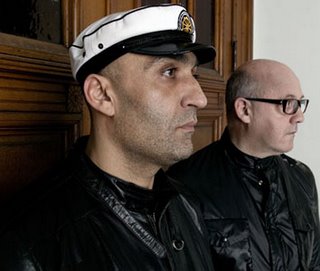
BAD DAD
Armen Eloyan - Narcisse Tordoir
26.01.2007 - 24.02.2007
opening reception 25.01.2007 6-9 p.m
Eloyan and Tordoir with "Bad Dad" seem to be offering a debasing statement. "Bad Dad" hints at a centralist re-installment of the Father figure, but unlike the mocking reversal of Peaches' "Fatherfuckers," Tordoir's and Eloyan's experiment does not seem to worry about a more moderate evaluation of gender and prefers to stick to a play with more truist notions of the male complexion. Where the title of the show may suggest a certain joy to be found in the ironic renegotiation of a politically non correct identity and all its associations, then the actual layout of the show testifies of the contrary. "Bad Dad" is a harsh, pretty direct but complex installation and leaves very little room for unequivocal clichés.
Both the recent works of Armen Eloyan and Narcisse Tordoir deal with historical documents. For Bleeding Nose, Magic Boots, and Untitled (all 2006) Eloyan has studied end of 19th century eastern European woodcut prints and embroidery that represents fairy tales and peasant stories. The original images are the product of primitivist, spellbound belief structures. Much like in propaganda imagery there is an imminent violence in the visual disposition of power distribution, gender relations and community order. The representation of life close to nature can be as harrowing. Eloyan's impression is devoid of naturalist detail, but chooses to render more incestuous - "Self-oriented" - forms of violence. A Dutch proverb for people who live in the countryside and go to bed early says "to go to sleep with the chicken." It accurately describes the environments and state of mind Eloyan is describing. When people live close to one another, otherness, transgression and violation all take place in a fuzzy zone that escapes a categorical application of Law. The paintings in objectif_exhibitions show us the consequences and dangers of such an embedding proximity, abruptly aborting the nostalgia for a rural moment of awakening and its devout composure. Blood, not spilled massively, but shed painfully takes up an important role in this series of works. Careful study of the works reveals that their spatial design is organized by spiral forms and z-shapes. Technically Eloyan based his brushwork on futurist paintings from the first half of the 20th century. The new unity of form and content is a mind-opener. Far from blowing life forward on revolutionary winds towards a prosperous future, these gestures in a sinister way seem to be re-inflicting the derailments of corporal violations, nationalism and a call for order.
There is a detached relationship of father to child in the disposition of the relationship of ethnographer to the uneducated, brutal savage. There is equally a desire to become one with the more romantic notions of savageness when ethnography turns into its more perverse pendant ethnofilia, and politically when it turns into its nationalist ally. Tordoir directs our attention to the extremities of this dialectic of unification and segregation. He has based himself on old anthropological prints of cannibals. The sholars who originally made these depictions must have been engaged in the creation of a savage otherness that would surpass the limits of any healthy form of imagination. People are chewing on large chunks of meat and the fierce determination of their complexion leaves no room for understanding or interpretation. Animals often have human traits, but humans turn into beasts every fifty to hundred years. When compared to the scientific precision, scale, and to the array and knowhow of physical destruction in our age, the animalistic meal becomes something of an index. It points away from its own inexistence towards other, more destructive moments more close to us. There is something utterly revealing and alarming in the indexical, but blatant reference to the universal destructive aspirations of bureaucratic imperialism today. Tordoir has gradually layered these elements into a series of drawings and paintings that take further inpiration from Pasolini's 1975, brutally repulsive motion picture "Salo" that was made as a reminiscence of the horrors of Benito Mussolini. On top of the images of the film, Tordoir has added today's fetishes, taken from a series of advertisements for computers, cell phones and fashion shoots.
Both Eloyan and Tordoir offer us a vision of the moment when "the bell tolls" which could be the ominous sound of a mobile phone.
Text by Wim Peeters. (2007)
objectif_exhibitions coquilhatstraat 14 2000 antwerp
thu-sat 2-6 pm
t+32 496 504 206
info@objectif-exhibitions.org
www.objectif-exhibitions.org
BAD DAD party at capital (stadspark) on 25.01.2007 from 10.30 p.m

1 comment:
zdf4ubnf3
supreme outlet
golden goose outlet
supreme outlet
golden goose outlet
golden goose outlet
golden goose outlet
golden goose outlet
golden goose outlet
golden goose outlet
golden goose outlet
Post a Comment